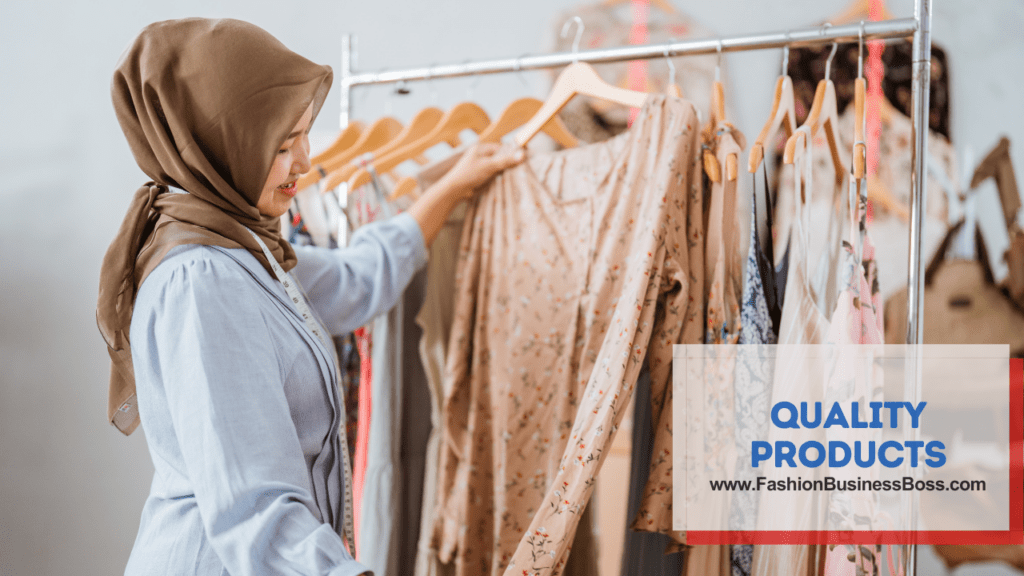Selling your clothing brand can be a thrilling venture, but it’s not all glitz and glamour. It takes meticulous planning, dedication, and a dash of creativity to stand out in the fiercely competitive fashion industry.
To sell your clothing brand, first, understand your audience and shape your brand identity. Build a strong online presence via a website and social media. Use e-commerce platforms, team up with influencers, and attend trade shows for broader exposure. Prioritize top-notch customer service and quality products to foster customer loyalty.
In this article, I will take you through the essential steps to sell your clothing brand, from defining your target audience to building a loyal customer base.
Understanding Your Target Audience
Market Research

Before you start selling your clothing brand, it’s crucial to get to know your potential customers well. That means finding out what they like, what they need, and what dreams they have. You can do this by digging deep into market research.
Market research is like being a detective for your business. You’ll gather all kinds of information about the people who might wear your clothes. What styles do they prefer? What colors make them happy? Do they have specific needs, like sustainable fabrics or plus-size options? All of this detective work helps you understand your audience better.
When you’ve got all this info, you’re like a tailor with a perfect fit. You can create clothes that your customers will love because you know what they want. Market research is like having a treasure map to progress.
Read more about: Designing Your Own Clothes: Unleash Your Inner Fashionista
Creating a Brand Identity
Imagine your clothing brand as a person with its personality. That’s your brand identity, and it’s what makes you stand out in the crowd. Your brand identity should be so unique and compelling that it grabs people’s attention and sticks in their minds.
Think of your brand as a storyteller. What story do you want to tell with your clothes? Maybe it’s about sustainability, adventure, or feeling confident. Whatever it is, make sure it speaks to your audience’s heart.
Your brand identity should also bring out emotions. When people see your logo or hear your brand’s name, it should make them feel something special. That emotional connection keeps customers coming back for more.
Building an Online Presence
Website Development
In today’s digital world, having a killer website is a must. It’s like having a shiny, welcoming store on the busiest street in town. Your website is where people will come to check out your clothing brand, so it needs to be top-notch.
Think of your website as the face of your brand online. It should be easy for visitors to use and look fantastic. When someone lands on your site, they should instantly see your clothing line in all its glory.
Investing in a user-friendly and visually appealing website is like rolling out the red carpet for your customers. Make sure it’s easy to navigate, with clear pictures and descriptions of your clothes. It’s your chance to impress and convince visitors to become loyal customers.
Social Media Stratey
Social media is your brand’s BFF (Best Friend Forever) in the online world. It’s where you can chat, share, and show off your clothing brand to the world. To make the most of it, you need a plan – that’s your social media strategy.
Imagine social media as a massive, bustling marketplace. It’s where potential customers hang out, so you want to be there too. Create posts that grab their attention and make them want to know more about your brand.
Engaging content, like beautiful photos and interesting stories about your clothes, is the secret sauce. Run targeted ads to reach the right people, and don’t forget to chat with your followers. It’s like having a friendly chat with shoppers in your store – except your store is online.
Expanding Your Reach
E-commerce Platforms

When it comes to selling your clothes online, e-commerce platforms are your trusty sidekicks. Think of them as your helpers who make the whole process smoother. Platforms like Shopify or WooCommerce are your go-to pals.
These platforms are like magic wands that turn your website into a super online store. They come with all sorts of tricks, like customizable options. You can make your store look and feel just the way you want. Plus, they keep all your customer’s payment info safe and sound.
Instead of building an online store from scratch, you can rely on these platforms. They’re like your online store’s backbone, giving it structure and security.
Read more about: Create Your Own Clothing: Express Your Unique Style
Influencer Collaborations
Ever seen someone you admire wear something and thought, “I want that too!”? That’s the power of influencers. These are folks who have a big following and can make people fall in love with your brand.
Imagine influencers as your brand’s megaphones. When they talk about your clothes, lots of people listen. But, it’s essential to pick influencers whose style and values match your brand’s. That way, their shoutouts will feel authentic and genuine.
Collaborating with influencers is like having a famous friend who helps you get noticed. It boosts your brand’s visibility and can lead to more sales. It’s a bit like teaming up with a superstar for a hit song – it gets everyone talking about your brand.
Trade Shows and Pop-Up Shops
While the digital world is fantastic, don’t forget about the real world. Trade shows and pop-up shops are like your brand’s chance to shine in person.
Think of trade shows as big parties where you get to introduce your brand to lots of people. You set up a cool booth, show off your clothes, and network with others in the industry. It’s like making friends and gaining exposure all in one place.
Pop-up shops, on the other hand, are like temporary stores that appear in cool locations. They give people a chance to touch, feel, and try on your clothes. It’s like throwing a mini fashion show but with your brand as the star.
Customer-Centric Approach
Exceptional Customer Service
When it comes to running a clothing brand, treating your customers like royalty is the golden rule. Think of it as being the host of a fantastic party – you want your guests to have a great time.
Exceptional customer service means being there for your customers every step of the way. It’s like having a helpful friend who’s always ready to assist. Answer their questions quickly, fix any problems that pop up, and make sure their shopping experience is as smooth as silk.
Responding to inquiries promptly is like picking up the phone when a friend calls – it shows you care. When issues arise, tackle them head-on, just like you would with a hiccup at a party. Solving problems swiftly keeps your customers happy and coming back for more.
Quality Products

Imagine your clothing as the heart of your brand. Its quality speaks louder than words. Investing in top-notch materials and craftsmanship is like giving your heart a strong beat.
High-quality products are like treasures that customers can’t resist. They feel good against the skin, last longer, and make customers trust your brand. It’s like serving delicious food at a party – everyone loves it, and they keep coming back for more.
Quality is your brand’s reputation. Just as a good reputation is essential in making friends, it’s vital in building a loyal customer base. People remember quality, and they’ll become your brand’s biggest fans. So, whether it’s a shirt, a dress, or a pair of jeans, always strive for the best quality to win your customers’ hearts.
Read more about: Creating a Thriving Clothing Brand from Scratch
Building Customer Loyalty
Loyalty Programs
Loyalty programs are like throwing a special party for your most loyal friends. In this case, your friends are your repeat customers, and you want to make them feel extra special.
Implementing a loyalty program is like giving your friends VIP passes. You can offer them exclusive discounts, so it’s like getting the best deals at the party. Early access to new collections is like letting them into the party before everyone else – it creates excitement.
Personalized recommendations are like knowing your friends’ favorite songs at the party. It shows you care about their preferences. When you reward your repeat customers, it’s like saying, “Thanks for being awesome!” It keeps them coming back and brings more friends to your brand’s party.
Email Marketing
Imagine email marketing as sending friendly letters to your customers. It’s a way to keep the conversation going even after they’ve left your online store.
Maintaining a strong email marketing strategy is like keeping in touch with your friends regularly. You can let them know about new arrivals – it’s like telling them about the latest gossip. Promotions are like inviting them to a cool party with great deals.
But here’s the special part – personalize your emails. It’s like writing a letter just for that friend. Use their name, recommend products they might like, and ask how they’re doing. It creates a warm, intimate connection, just like chatting with a friend over coffee.
Email marketing keeps your brand on your customers’ minds. It’s like sending friendly reminders that you’re there for them. So, just like with friends, stay in touch, and your customers will keep coming back to your brand’s party.
Adapting to Changing Trends
Stay Informed
The fashion world is always changing, like the weather. To keep your clothing brand on top, stay in the know. Stay updated on the latest trends, like what’s hot and what’s not.
Also, check out sustainability practices – it’s like being eco-friendly at home. And don’t forget about what your customers want. Like asking your friends what they like to do. Adapt your brand strategy just like you’d change your plans based on the weather. Stay informed, and your brand will always shine.
Understanding Cultural Nuances
Cultural Sensitivity

When taking your clothing brand worldwide, it’s like traveling to new places. You need to be aware of the local customs and cultures – it’s like learning the local language to connect better.
Recognize that people have different ways of doing things, and it’s essential to respect those differences. It’s similar to understanding that your friends have unique traditions. Being culturally sensitive is like being a great guest at a friend’s house – you show respect and appreciation. By doing this, you’ll create a welcoming and inclusive brand that can thrive globally.
Read more about: Custom Wholesale Clothing: Elevate Your Brand’s Identity
Engaging with Your Audience
Natural Language
When it comes to your brand’s voice, think of it as talking to a buddy. Use everyday words and keep it friendly. Imagine you’re chatting over coffee, not giving a formal speech.
Conversational language makes your brand approachable. It’s like meeting someone who’s easy to talk to at a party. When your audience feels like they’re talking to a friend, they’ll connect with your brand on a personal level. It’s like having a casual chat that turns into a long-lasting friendship.
Humor and Friendliness
Adding humor and friendly banter to your brand is like telling jokes at a party – it lightens the mood and makes people smile. Just like with friends, it’s all about finding the right moments to be funny.
A light-hearted approach makes your brand relatable. It’s like having a good laugh with pals. When you make your audience chuckle or grin, it creates a positive and memorable experience. It’s like sharing inside jokes that only close friends understand. So, sprinkle some humor and friendliness into your branding – it’s the secret sauce that keeps your brand’s conversations lively and enjoyable.
Timely Responses and Respect
Timeliness
When it comes to responding to your customers, think of it like texting a friend. You want to reply fast, but you also want your response to sound like it’s coming from a real person, not a robot.
Being quick in your responses shows you care. It’s like not making your friend wait when they ask a question. But it’s also essential to make your response feel genuine, like you’re having a friendly chat.
Respect Boundaries
Just as you respect your friend’s personal space, you need to do the same with your customers. Always consider their preferences and boundaries. It’s like knowing when not to bring up a sensitive topic in a conversation.
Privacy and consent are like locked doors in a house. You should always ask before entering someone’s private space. Whether it’s using their data or contacting them, respecting boundaries is key to building trust and maintaining a healthy relationship with your customers.
Empathy in Customer Interactions
Empathetic Communication

When dealing with customer concerns or complaints, think of it like talking to a friend who’s going through a tough time. Show that you understand and care about their feelings.
Empathetic communication is like giving your friend a comforting hug when they’re upset. It’s about listening, acknowledging their concerns, and letting them know you’re there to help.
A little understanding goes a long way in building trust and loyalty. It’s like being a supportive friend – your customers will remember your kindness and be more likely to stick with your brand.
Read more about: Demystifying Clothing Labels: What Every Shopper Should Know
Summary
Selling your clothing brand involves a mix of strategy, creativity, and genuine customer engagement. By understanding your audience, building a strong online presence, and providing exceptional products and services, you can carve out a niche in the competitive fashion industry.
Frequently Asked Questions

1. How can I identify my target audience for my clothing brand?
To pinpoint your target audience, conduct market research, and analyze demographics, psychographics, and consumer behavior. Use these insights to tailor your brand and marketing efforts effectively.
2. What’s the importance of collaborating with influencers in clothing brand sales?
Influencer collaborations can expand your brand’s reach, tap into established audiences, and build authenticity. Choose influencers aligned with your brand values to create genuine connections.
3. How can I adapt to changing fashion trends while staying true to my brand identity?
Adaptation is key. Stay updated on trends, but infuse your unique brand personality into them. Find the right balance to remain relevant and authentic.
To learn more about starting your own clothing business, check out my startup documents here.
The information provided by FashionBusinessBoss.com (“The Site”) is for general informational purposes only. All information on the Site is provided in good faith, however, we make no representation or warranty of any kind, express or implied, regarding the accuracy, adequacy, validity, reliability, availability or completeness of any information on the Site. Under no circumstance shall we have any liability to you for any loss or damage of any kind incurred as a result of the use of the Site or Reliance on any information provided on the Site. Your use of the Site and your reliance on any information on the Site is solely at your own risk. This blog post is for educational purposes only and does not constitute legal advice. Please consult a legal expert to address your specific needs. Terms and Conditions. (https://fashionbusinessboss.com/terms-and-conditions/)

Meet Shawn Chun: Entrepreneur and Fashion Business Fan.
I’m a happy individual who happens to be an entrepreneur. I have owned several types of businesses in my life from a coffee shop to an import and export business to an online review business plus a few more and now I create online resources for those interested in starting new ventures. It’s demanding work but I love it. I do it for those passionate about their business and their goals. That’s why when I meet a designer or boutique owner at a craft fair, farmers market, retail location or anywhere else I see myself. I know how hard the struggle is to retain clients, find good employees and keep the business growing all while trying to stay competitive.
That’s why I created Fashion Business Boss: I want to help fashion business owners like you build a thriving business that brings you endless joy and supports your ideal lifestyle.

